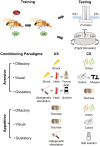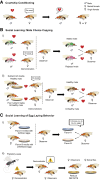Diverse memory paradigms in Drosophila reveal diverse neural mechanisms
- PMID: 38862165
- PMCID: PMC11199951
- DOI: 10.1101/lm.053810.123
Diverse memory paradigms in Drosophila reveal diverse neural mechanisms
Abstract
In this review, we aggregated the different types of learning and memory paradigms developed in adult Drosophila and attempted to assess the similarities and differences in the neural mechanisms supporting diverse types of memory. The simplest association memory assays are conditioning paradigms (olfactory, visual, and gustatory). A great deal of work has been done on these memories, revealing hundreds of genes and neural circuits supporting this memory. Variations of conditioning assays (reversal learning, trace conditioning, latent inhibition, and extinction) also reveal interesting memory mechanisms, whereas mechanisms supporting spatial memory (thermal maze, orientation memory, and heat box) and the conditioned suppression of innate behaviors (phototaxis, negative geotaxis, anemotaxis, and locomotion) remain largely unexplored. In recent years, there has been an increased interest in multisensory and multicomponent memories (context-dependent and cross-modal memory) and higher-order memory (sensory preconditioning and second-order conditioning). Some of this work has revealed how the intricate mushroom body (MB) neural circuitry can support more complex memories. Finally, the most complex memories are arguably those involving social memory: courtship conditioning and social learning (mate-copying and egg-laying behaviors). Currently, very little is known about the mechanisms supporting social memories. Overall, the MBs are important for association memories of multiple sensory modalities and multisensory integration, whereas the central complex is important for place, orientation, and navigation memories. Interestingly, several different types of memory appear to use similar or variants of the olfactory conditioning neural circuitry, which are repurposed in different ways.
© 2024 Dwijesha et al.; Published by Cold Spring Harbor Laboratory Press.
Figures



Similar articles
-
Learning and memory in Drosophila: behavior, genetics, and neural systems.Int Rev Neurobiol. 2011;99:139-67. doi: 10.1016/B978-0-12-387003-2.00006-9. Int Rev Neurobiol. 2011. PMID: 21906539 Review.
-
Memory Elicited by Courtship Conditioning Requires Mushroom Body Neuronal Subsets Similar to Those Utilized in Appetitive Memory.PLoS One. 2016 Oct 20;11(10):e0164516. doi: 10.1371/journal.pone.0164516. eCollection 2016. PLoS One. 2016. PMID: 27764141 Free PMC article.
-
Shared mushroom body circuits underlie visual and olfactory memories in Drosophila.Elife. 2014 Aug 19;3:e02395. doi: 10.7554/eLife.02395. Elife. 2014. PMID: 25139953 Free PMC article.
-
How does the insect central complex use mushroom body output for steering?Curr Biol. 2018 Jul 9;28(13):R733-R734. doi: 10.1016/j.cub.2018.05.060. Curr Biol. 2018. PMID: 29990452
-
Cellular and circuit mechanisms of olfactory associative learning in Drosophila.J Neurogenet. 2020 Mar;34(1):36-46. doi: 10.1080/01677063.2020.1715971. Epub 2020 Feb 11. J Neurogenet. 2020. PMID: 32043414 Free PMC article. Review.
Cited by
-
What do the mushroom bodies do for the insect brain? Twenty-five years of progress.Learn Mem. 2024 Jun 11;31(5):a053827. doi: 10.1101/lm.053827.123. Print 2024 May. Learn Mem. 2024. PMID: 38862175 Free PMC article.
-
The Drosophila adult brain: short overview of structure, function, and resources Graphical Review Paper.Curr Res Insect Sci. 2025 May 15;7:100113. doi: 10.1016/j.cris.2025.100113. eCollection 2025. Curr Res Insect Sci. 2025. PMID: 40510592 Free PMC article. Review.
-
Goal-directed behavior in Tenebrio molitor larvae.Sci Rep. 2024 Sep 17;14(1):21706. doi: 10.1038/s41598-024-72455-3. Sci Rep. 2024. PMID: 39289503 Free PMC article.
References
Publication types
MeSH terms
LinkOut - more resources
Full Text Sources
Medical
Molecular Biology Databases
Miscellaneous
